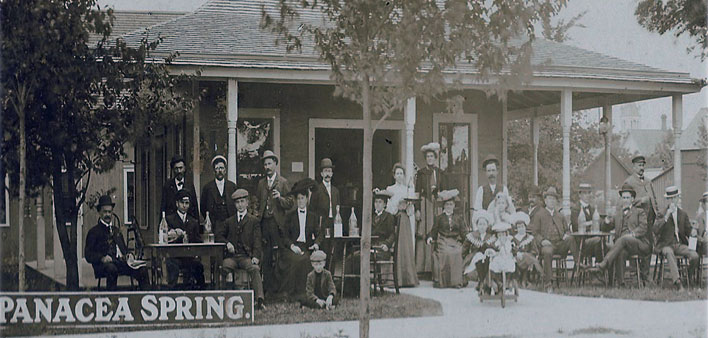Springtime at the Springs – 1903

By Kim Parr
At the turn of the century it was common to see people gathered outside in Mount Clemens once the warm days of spring arrived. They would enjoy crisp, refreshing water from one of the many natural spring water sites in town.
It began in 1890 when a visitor to the Avery House declared that proprietor Edwin Egnew helped cure him of chronic ills using the nearby spring water. After some initial skepticism Egnew built the first natural spring water venture, Pagoda Springs. In July of 1891 Egnew acquired a 10 year lease on a natural surface spring. The water was analyzed by chemist C. Gilbert Wheeler of Chicago, who advised in a telegram that the water “will make you a fortune if judicially managed.”
Egnew erected a beautiful oriental-style pagoda on Dickinson Street. The location was determined in accordance with his superstitious nature. His American eagle pet named “Dick” within the Avery House was the hotel’s mascot. One day the eagle escaped outside and fl ew around until it was so exhausted it fell to the ground. On this very spot he constructed the pagoda.
The spring water was advertised as “a fi ne purgative and liver stimulant” and was sold in bottles with the nickname “Little Pody.” It was actually tasteless and inodorous and not contaminated, unlike a lot of water people were drinking. It was highly recommended for those addicted to the excessive use of a meat diet. It was useful in treating kidney diseases and digestive disorders due to liver derangement. The Michigan Central Railroad served this water aboard its dining cars and used 900 bottles weekly in 1893. Pagoda Springs even had its very own band that would entertain its guests and march in parades to promote the Pagoda water.
Every Saturday a guessing contest was held for the amusement of visitors. During this time the water was free to all, and the one who guessed the nearest to the number of glasses of Pagoda water drank in these two hours received, as a prize, one case of the Pagoda water.
Due to the Egnew’s success other springs soon followed. Frank W. Preussel is pictured with Mae Preussel right. They opened Panacea Spring in 1903; it was located at the corner of Crocker Boulevard and Second Street. The water was advertised to be a remedy for a great number of ailments. Panacea featured an octagonal pavilion with an orchestra balcony, and could accommodate up to 500 guests. The pavilion also had a polished maple floor for dancing. The spacious gardens around the pavilion were fitted with many tables and chairs to sit and enjoy popcorn with an unlimited amount of water for five cents per person. The all-time champ was said to have drank 14 gallons of the water.
The Preussels sold their business to Louis Green of Elizabethtown, New Jersey in 1919. In 1930 Harry Hulburt, a former Jackson State Prison warden, reorganized the business due to financial setbacks. The hard times caused by the Great Depression proved too difficult for the Panacea, forcing it to close in 1936. Mount Clemens saw a total of 15 spring water sites throughout the early part of the 1900s.
Photos provided by the collection of the Macomb County Historical Society & Crocker House Museum. Kim Parr is the director of the Macomb County Historical Society & Crocker House Museum. For more visit crockerhousemuseum.org.

